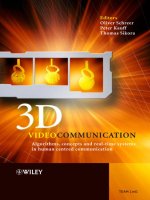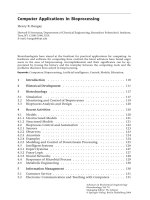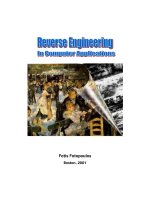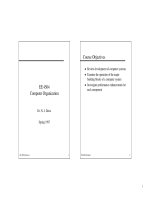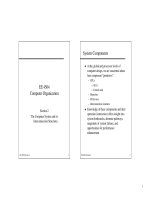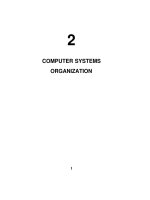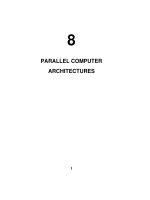Computer concepts chapter01
Bạn đang xem bản rút gọn của tài liệu. Xem và tải ngay bản đầy đủ của tài liệu tại đây (2.07 MB, 59 trang )
Chapter 1
Computers and Digital Basics
1
Chapter Contents
Section A: All Things Digital
Section B: Digital Devices
Section C: Digital Data Representation
Section D: Digital Processing
Section E: Password Security
Chapter 1: Computers and Digital Basics
2
FastPoll True/False Questions
1
Answer A for True and B for False
010100 The Web is just another name for the Internet.
010200 A computer’s operating system is a type of application software.
010300 Microcontrollers are special purpose microprocessors that can be embedded in
devices such as refrigerators, cars, and washing machines.
010400 A bit is a binary digit, such as a 1 or 0.
Chapter 1: Computers and Digital Basics
3
3
FastPoll True/False Questions
1
Answer A for True and B for False
010500 ASCII, EBCDIC, and Unicode are used to represent character data.
010600 A megabyte is 1024 bits.
010700 Microprocessors are a type of integrated circuit.
010800 C, COBOL, and Java are examples of programming languages.
Chapter 1: Computers and Digital Basics
4
4
FastPoll True/False Questions
1
Answer A for True and B for False
010900 A compiler converts source code to object code.
011000 The list of codes for a microprocessor’s instruction set is called machine
language.
011100 A microprocessor holds data in the interpreter register.
011200 A dictionary attack is a virus that hides out in the spelling checker for your word
processing software.
Chapter 1: Computers and Digital Basics
5
5
SECTION
1
All Things Digital
The Digital Revolution
Convergence
Digital Society
Chapter 1: Computers and Digital Basics
6
A
1
Question
012100 Computers and the digital revolution have changed our lives in many fundamental
ways. If you were on the front lines of the digital revolution when computers were first
developed to break codes and calculate missile trajectories, you were most likely living in
what time period?
–
–
–
–
A. World War I
B. The roaring twenties
C. World War II
D. The 1960s
Chapter 1: Computers and Digital Basics
7
1
The Digital Revolution
The digital revolution is an ongoing process of social, political, and economic change brought about by
digital technology, such as computers and the Internet
Revolves around a constellation of technologies, including digital electronics, computers,
communications networks, the Web, and digitization
Chapter 1: Computers and Digital Basics
8
1
The Digital Revolution
Digital electronics use electronic circuits to represent data
Today, digital electronic devices include computers, portable media players such as iPods, digital
cameras and camcorders, cell phones, radios and televisions, GPSs, DVD and CD players, e-book
readers, digital voice recorders, and handheld gaming consoles
Chapter 1: Computers and Digital Basics
9
1
The Digital Revolution
Chapter 1: Computers and Digital Basics
10
1
The Digital Revolution
The second phase of the digital revolution materialized when the Internet was opened to public use
–
–
–
–
Bulletin boards
Blogs
Online social
networks
Chapter 1: Computers and Digital Basics
11
1
The Digital Revolution
A computer network is a group of computers linked by wired or wireless technology to share data and
resources
The Web is a collection of linked documents, graphics, and sounds that can be accessed over the
Internet
Cyberspace is a term that refers to entities that exist largely within computer networks
Digitization is the process of converting text, numbers, sound, photos, and video into data that can be
processed by digital devices
Chapter 1: Computers and Digital Basics
12
1
Convergence
Technological convergence is a process by which several
technologies with distinct functionalities evolve to form a single
product
Convergence tends to offer enhanced functionality and convenience
Chapter 1: Computers and Digital Basics
13
1
Digital Society
Digital technologies and communications networks make it easy to cross cultural and geographic
boundaries
Anonymous Internet sites, such as Freenet, and anonymizer tools that cloak a person’s identity, even
make it possible to exercise freedom of speech in situations where reprisals might repress it
Citizens of free societies have an expectation of privacy
Intellectual property refers to the ownership of certain types of information, ideas, or representations
Chapter 1: Computers and Digital Basics
14
1
Digital Society
Digital technology is an important factor in global and national economies, in addition to affecting the
economic status of individuals
Globalization can be defined as the worldwide economic interdependence of countries that occurs as
cross-border commerce increases and as money flows more freely among countries
Individuals are affected by the digital divide, a term that refers to the gap between people who have
access to technology and those who do not
Digital technology permeates the very core of modern life
Chapter 1: Computers and Digital Basics
15
SECTION
1
Digital Devices
Computer Basics
Personal Computers, Servers, Mainframes, and Supercomputers
Handheld Devices
Microcontrollers
Chapter 1: Computers and Digital Basics
16
B
1
Question
012200 Today, consumers can choose from a wide variety of digital devices, including personal computers, workstations,
videogame consoles, smartphones, iPods, and PDAs. Knowing the strengths of these devices helps you make the right
choice. What is the fundamental difference between videogame consoles, personal computers, and smartphones?
–
A. Video game consoles and smartphones are not be classified as computers because they don’t have stored program
capabilities like real computers.
–
–
–
B. Videogame consoles and smartphones fill specialized niches and are not replacements for personal computers.
C. Personal computers and smartphones can be used to access the Internet, whereas videogame consoles cannot.
D. Personal computers and smartphones have better graphics than videogame consoles.
Chapter 1: Computers and Digital Basics
17
17
1
Computer Basics
A computer is a multipurpose device that accepts input, processes data, stores data, and produces
output, all according to a series of stored instructions
Chapter 1: Computers and Digital Basics
18
1
Computer Basics
Computer input is whatever is typed, submitted, or transmitted to a computer
system
Output is the result produced by a computer
Data refers to the symbols that represent facts, objects, and ideas
Computers manipulate data in many ways, and this manipulation is called
processing
–
–
Central Processing Unit (CPU)
Microprocessor
Chapter 1: Computers and Digital Basics
19
1
Computer Basics
Memory is an area of a computer that temporarily holds data waiting to be processed, stored, or output
Storage is the area where data can be left on a permanent basis when it is not immediately needed for
processing
A file is a named collection of data that exists on a storage medium
The series of instructions that tells a computer how to carry out processing tasks is referred to as a
computer program
–
Software
Chapter 1: Computers and Digital Basics
20
1
Computer Basics
A stored program means that a series of instructions for a computing task can be loaded into a
computer’s memory
–
–
Allows you to switch between tasks
Distinguishes a computer from other simpler and less versatile digital devices
Chapter 1: Computers and Digital Basics
21
1
Computer Basics
Application software is a set of computer programs that helps a person carry out a task
The primary purpose of system software is to help the computer system monitor itself in order to function
efficiently
–
Operating system (OS)
Chapter 1: Computers and Digital Basics
22
1
Personal Computers, Servers, Mainframes, and Supercomputers
A personal computer is a microprocessor-based computing device designed to meet the computing
needs of an individual
Chapter 1: Computers and Digital Basics
23
1
Personal Computers, Servers, Mainframes, and Supercomputers
The term workstation has two meanings:
–
–
An ordinary personal computer that is connected to a network
A powerful desktop computer used for high-performance tasks
Chapter 1: Computers and Digital Basics
24
1
Personal Computers, Servers, Mainframes, and Supercomputers
A videogame console, such as Nintendo’s Wii, Sony’s PlayStation, or Microsoft’s
Xbox, is not generally referred to as personal computer because of their history as
dedicated game devices
Chapter 1: Computers and Digital Basics
25

